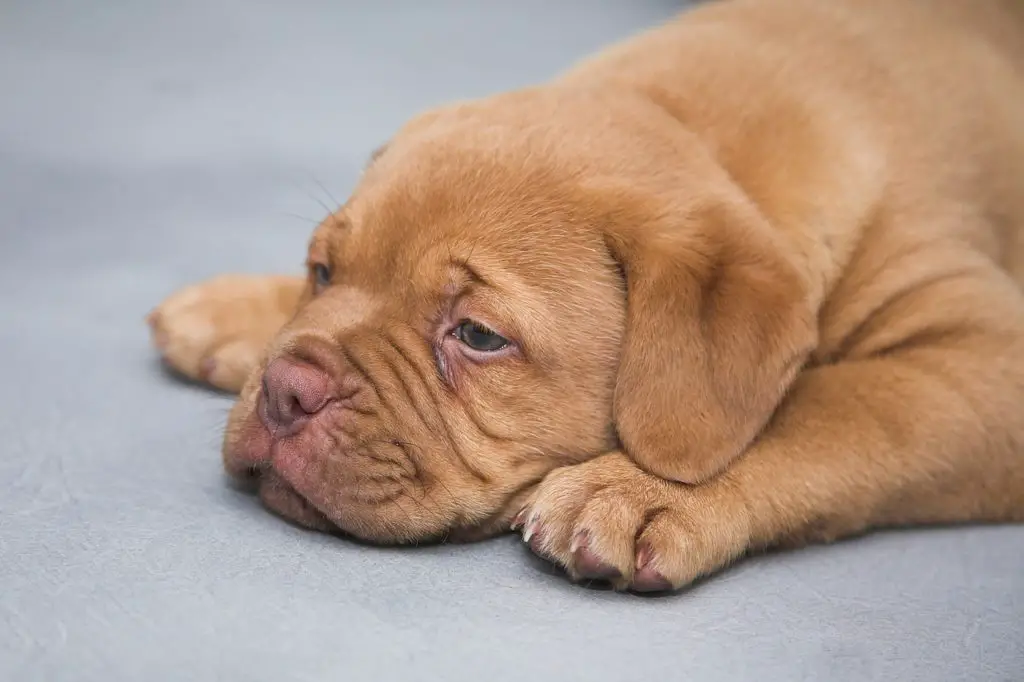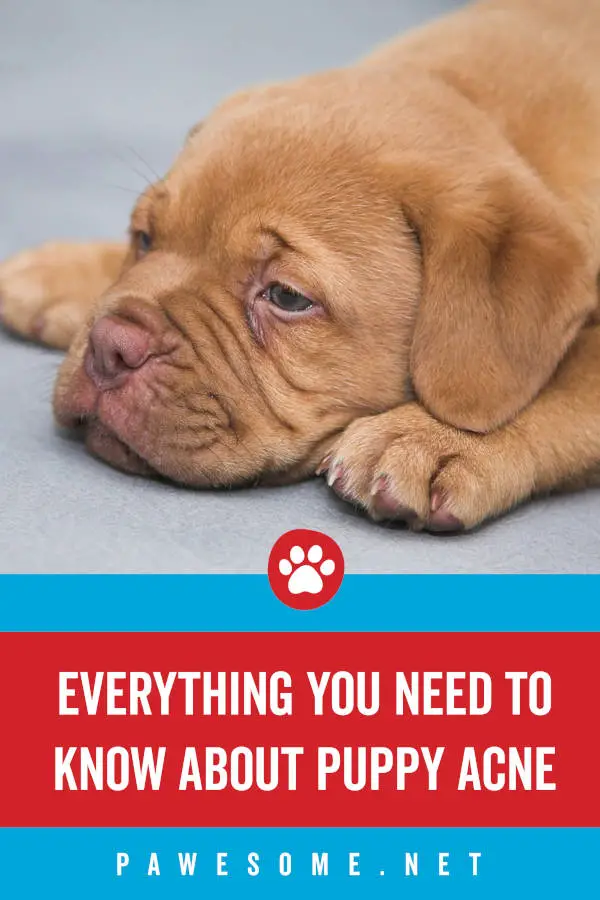
Remember all those nasty pimples and zits you had in high school? What if I told you that your dog went through the same problem and that you might not have even known about it?
I’m talking about puppy acne. Because dogs are covered in fur, it can be easy to miss a skin problem. Your dogs’ acne (like yours) eventually went away when you finished going through puberty. Let’s talk a little more about this problem.
The Problem of Puppy Acne
There are a lot of different factors that can cause puppies to develop an acne problem. The first thing to understand is that this problem will occur in most dogs no matter what you do.
It is perfectly natural for puppies to go through a phase of acne at about three months. However, it is up to you as a caretaker to make sure that the problem does not get out of hand.
As with humans, these kinds of outbreaks are often just the natural result of hormonal changes. Sometimes, the problem can also be aggravated by outside factors that make the acne go from bad to worse.
Luckily, there are a lot of things that you can do in response to this problem. We will cover this and much more in the sections below.
Related: What Is Puppy Underbite?
Causes of Dog Acne
The most frequent cause of acne problems in pups is poor hygiene. The dirtier their skin is, the more likely it is that they will develop some kind of infection.
The hair follicles of all mammals secrete a substance called sebum, which is an oily, waxy substance used to lubricate the hair and skin with a protective coating. However, the residue left behind by the sebum is a leading cause of acne.
When that problem is compounded with general uncleanliness, it will become much worse. Another frequent cause of pup acne is physical injury.
When rough-playing with their littermates, minor abrasions of the snout and jaw can occur. A plastic food bowl with rough chewed edged can also cause minor cuts and scrapes, and all of these little cuts and scrapes have the potential to be infected.
If your puppy spends a lot of time in the yard, they will likely spend a lot of their time playing and rooting. This can cause small abrasions if they root against sharp rocks, old broken glass, or any of the other sharp things that may be found underground.
There are also certain insects and rodents that live underground and which can give a nasty bite that may become infected. If this has occurred, and you know about it, you can remove any venom that may be present by pressing a small wad of wetted tobacco against the area where the bite occurred.
Allergic reactions are another common aggravator of pup acne. Genetics also seem to play a role, simply because some breeds are more susceptible than others.
As a general rule, dogs with short hair are much more likely to pick up an acne problem, presumably because there is simply not as much of a barrier between their skin and the outside world. Boxers, Bulldogs, Doberman Pinschers and Great Danes are a few of the breeds that seem particularly vulnerable to these kinds of skin problems.
Finally, you should be aware that some skin infections can be caused by parasites such as ringworm. Ringworm-induced acne has a different look compared to normal acne, so be careful if your dog’s acne looks strange or misshapen or particularly discolored.
Symptoms of Canine Acne
The symptoms of this problem are similar to those that you would see in a human. You will see red, raised bumps (or blackheads) that may leak blood and/or pus.
You may also see a lot of dry, cracked, and flaky skin in the affected areas. This is mostly due to the deformation of the skin layer that is caused by the infected pustules.
The issue here is that a pup’s face is a lot hairier than yours, and you cannot be bothered to meticulously check underneath their fur every day. This is why you must look for other symptoms.
If your puppy has a habit of rubbing their chin or other parts of their body across the carpet, and you don’t see any signs of flea infestation, you might need to check them. The acne will normally be concentrated around the snout and mouth, as well as the groin and genital regions. In serious cases, you may notice the problem because of a large swelling effect.
How to Prevent Puppy Acne
Since pup acne is a predictable and common problem, it can be dealt with through preventative measures. The best thing you can do is to keep your puppy’s environment as clean as possible.
Acne is, in essence, a bacterial infection, and a clean living area will do much to prevent that bacteria from taking root. You can also do your best to prevent physical injury by always giving them a smooth, clean bowl to use.
In general, try to keep puppies away from anything sharp or rough because they tend to chew on everything. Just as it is important to keep the living area clean, it is equally important to keep your pup clean by bathing them as often as possible.
Not only will this make it easier to bathe them when they grow up, but it will also help to prevent the spread of disease and bacteria. Finally, you can try switching dog foods if you suspect that your dog might be allergic to your current brand.
Easy Ways to Treat Puppy Acne at Home
If prevention has already failed, and your puppy has developed a problematic infection, you can do several things to try and correct the problem at home. One thing to remember is that you should resist the natural urge to squeeze the pustules.
Without proper guidance, doing this can actually help the infection to spread. When you pop a great big sack of pus, and it squirts out, it will no doubt get on your puppy’s skin.
Even if you can sterilize the area effectively, removing all chance of secondary infection, you still run a risk of scarring your puppy’s skin. Since these acne issues will usually be concentrated around the snout and mouth, this can be a big deal.
You can wipe it off and sterilize the area, but if you don’t do so properly you will have helped the infection to colonize new areas. You should also avoid using rubbing alcohol at all. While this chemical can help in treating human acne, it is just too harsh for your dog.
If your dogs are a little feisty, as mine are, applying a harsh antiseptic like alcohol can be a little dangerous. For any reasonable creature, there is a tendency to respond in kind when someone hurts them.
If you hurt them, their natural reaction will be to hurt you. As such, you can’t blame anyone but yourself if you are bitten as a result of your foolishness.
Benzoyl peroxide (in a weak solution) is the preferred remedy for canine acne of any type. Alternatively, you can use a solution of salt water if benzoyl peroxide is not available.
When You Should Call a Vet for Treatment
One of the most important decisions that you have to make is whether or not to call a veterinarian. This decision must be evaluated in terms of the specifics of the problem.
To put it another way, it will depend on the situation. If you catch the problem early, your chances of avoiding a vet visit are much better.
As a general rule, small bumps are not a big cause for concern. However, if you see any significant swelling around the affected areas, you need to call the vet right away.
When the site of an infection begins to swell, it is a sign that the problem has become internal and will result in a serious internal infection if it hasn’t already become so.
However, if the problem has become really bad, you need to make sure you don’t waste any time in getting your pup to the vet. If your puppy has developed large pustules that look like giant pimples, you’ve got something a little worse than normal pup acne on your hands.
There is a common canine skin condition called demodectic mange, which can often be mistaken for acne. The most obvious symptom of demodectic mange is the development of huge pimples and the loss of small patches of hair around the pimples (technically called pustules, for those who don’t know).
If your pup has developed demodectic mange, the problem will not simply be concentrated around the snout, mouth, and groin. A dog with demodectic mange will usually have sores at random points all over their bodies.
This condition needs to be treated with medication by an experienced person because it will only get worse. Veterinarians can test a sample and determine for sure if your pup has acquired the mange.
If this occurs, don’t freak out because demodectic mange isn’t really that bad. Sarcoptic mange is far worse and poses a greater risk to the health of the dog. Demodectic mange is much easier to treat than its bigger, meaner cousin.
Bear in mind that your veterinarian will have access to medicines and materials that you simply cannot get. There are also certain medications that can be dangerous if used improperly, so don’t try to play vet if you don’t know what you’re doing.
In general, your main rule is to keep an eye on the problem and determine if the situation is getting worse or getting better. If the infection continues to worsen in spite of your best efforts, you would be irresponsible if you didn’t call in an experienced professional.
Overall Thoughts
I would say that the problem of pup acne needs to be approached logically and intelligently. If you are willing to learn a little bit about the subject, it will do your dog a lot of good.
By educating yourself, you can better decide when and how to treat the acne problem, and also when to call the doctor. Don’t hold off on that phone call just because you don’t want to spend the money. Remember, this is probably the most loyal friend you’ve got, and it is your job (and no one else’s) to make sure that they are cared for properly.

